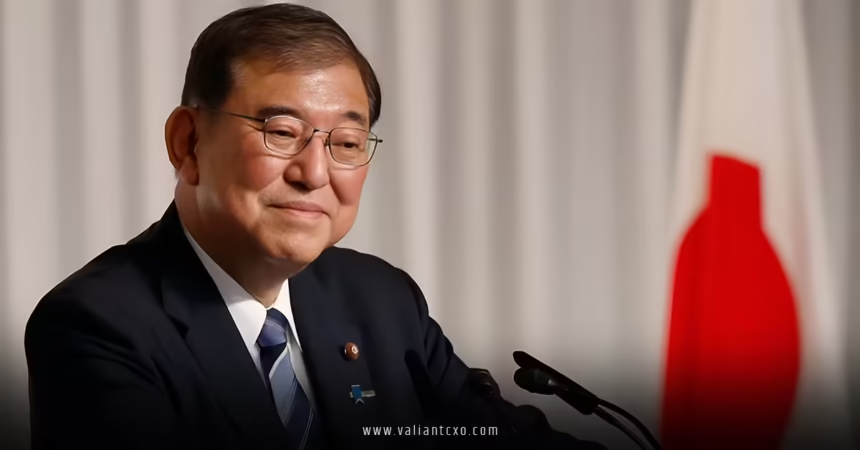Japanese Prime Minister Shigeru Ishiba has become a pivotal figure in Japan’s political landscape, steering the nation through turbulent times with a blend of experience and ambition. As the leader of the Liberal Democratic Party (LDP) and Japan’s prime minister since October 2024, Ishiba’s journey to the top is a story of persistence, policy expertise, and a vision for a revitalized Japan. But who is this man navigating the world’s fourth-largest economy through economic headwinds, geopolitical tensions, and domestic challenges? Let’s dive into the life, career, and legacy of Japanese Prime Minister Shigeru Ishiba, exploring what makes him tick and how he’s shaping Japan’s future.
Early Life and Roots of Japanese Prime Minister Shigeru Ishiba
Born on February 4, 1957, in Tokyo, Japanese Prime Minister Shigeru Ishiba grew up in a family steeped in public service. His father, Jirō Ishiba, was a prominent politician, serving as Tottori Prefecture’s governor and later as a minister in Japan’s national government. Imagine growing up in a household where political discussions were as common as breakfast conversations—this was Ishiba’s childhood. Raised in Tottori Prefecture, far from Tokyo’s hustle, he developed a grounded perspective that still influences his policies today.
Ishiba’s academic journey took him to Keio University, where he studied law. After a brief stint as a banker, he felt the pull of politics, a calling that ran in his blood. By 1986, at just 29, Japanese Prime Minister Shigeru Ishiba won a seat in the House of Representatives, launching a career that would span nearly four decades. His early years in politics weren’t glamorous, but they laid the foundation for a leader who’d later tackle Japan’s toughest challenges.
The Political Journey of Japanese Prime Minister Shigeru Ishiba
Rising Through the Ranks
Japanese Prime Minister Shigeru Ishiba’s political career is like a marathon, not a sprint. Elected in 1986 as an LDP member, he quickly carved out a niche as a policy wonk, focusing on agriculture and defense. These weren’t flashy portfolios, but they suited Ishiba’s detail-oriented style. He served as parliamentary vice minister of agriculture under Prime Minister Kiichi Miyazawa, gaining hands-on experience in governance.
In 1993, Ishiba briefly left the LDP to join the Japan Renewal Party, a bold move that showed his willingness to challenge the status quo. Think of it like a chef experimenting with a new recipe—it didn’t quite work out, but it taught him valuable lessons. He returned to the LDP in 1997, stronger and more focused, taking on roles like Director-General of the Defense Agency and Minister of Defense under Yasuo Fukuda.
A Maverick in the LDP
Japanese Prime Minister Shigeru Ishiba has often been called a “lone wolf” in the LDP, and for good reason. He’s never shied away from criticizing party policies, even when it ruffled feathers. His clashes with heavyweights like Shinzo Abe made him a polarizing figure within the LDP. Yet, this contrarian streak earned him respect among voters who saw him as authentic—a politician who speaks his mind rather than towing the party line.
Ishiba’s persistence shone through in his multiple bids for LDP leadership. He ran five times before winning in September 2024, defeating ultra-conservative Sanae Takaichi in a tight runoff. It was a moment of triumph for Japanese Prime Minister Shigeru Ishiba, proving that grit and a clear vision can outlast even the toughest political machines.
Key Policies and Vision of Japanese Prime Minister Shigeru Ishiba
Revitalizing Rural Japan
One of Japanese Prime Minister Shigeru Ishiba’s flagship goals is breathing new life into Japan’s rural regions. Cities like Tokyo and Osaka often hog the spotlight, but Ishiba knows that Japan’s heart beats in its countryside. His “Safety and Security for All” campaign emphasizes decentralizing economic growth, encouraging businesses to set up shop outside urban hubs, and improving digital infrastructure in rural areas. It’s like giving a neglected garden some much-needed water and sunlight—Ishiba believes these regions can bloom again.
Strengthening National Security
As a defense policy expert, Japanese Prime Minister Shigeru Ishiba has bold ideas for Japan’s security. He’s proposed an Asian equivalent of NATO, a collective defense framework to counter regional threats like China’s growing assertiveness. This idea has sparked debate—some call it visionary, others unrealistic. Imagine trying to herd cats from different countries into one cohesive alliance; that’s the challenge Ishiba faces.
He’s also pushed for a more equal Japan-U.S. security alliance, suggesting joint management of U.S. bases in Japan and even Japanese Self-Defense Force bases in the U.S. It’s a daring vision, aiming to shift Japan from a junior partner to an equal player on the global stage.
Social Reforms and Inclusivity
Japanese Prime Minister Shigeru Ishiba has shown a progressive side on social issues. In his 2024 book, A Conservative Politician, he voiced support for same-sex marriage, arguing that it’s a matter of fundamental human rights. This stance is bold in a country where traditional values often dominate. However, as prime minister, he’s taken a more cautious approach, citing the need to consider court rulings and constitutional constraints. It’s like walking a tightrope—balancing progressive ideals with political realities.
Ishiba also supports allowing married couples to use separate surnames, a reform that challenges Japan’s conservative family laws. These positions show his willingness to tackle sensitive issues, even if they don’t win him universal applause.
Challenges Faced by Japanese Prime Minister Shigeru Ishiba
Electoral Setbacks and Political Turmoil
Japanese Prime Minister Shigeru Ishiba’s tenure hasn’t been a smooth ride. Shortly after taking office in October 2024, his coalition lost its majority in the lower house, followed by another defeat in the upper house in July 2025. These losses were like punches to the gut for the LDP, which has dominated Japanese politics for decades. Voter frustration over rising living costs, a rice shortage, and a lingering political finance scandal fueled the backlash.
Ishiba’s decision to call snap elections in October 2024 was a gamble that backfired. The LDP-Komeito coalition lost ground to emerging right-wing parties like Sanseito, which capitalized on anti-immigration sentiment and nationalist rhetoric. For Japanese Prime Minister Shigeru Ishiba, these defeats underscored the fragility of his minority government, forcing him to navigate a fractured political landscape.
Economic Headwinds and Trade Tensions
Leading the world’s fourth-largest economy is no small feat, and Japanese Prime Minister Shigeru Ishiba has faced relentless economic challenges. Inflation, hovering around 3%, has squeezed households, while stagnant wages have left many feeling left behind. A rice shortage, blamed on outdated agricultural policies, became a political lightning rod, with prices doubling in a year.
On the international front, Ishiba clinched a trade deal with the U.S. in 2025, reducing tariffs on Japanese exports from 27.5% to 15%. It was a hard-fought win, but critics argue it came at a steep cost, with Japan pledging $550 billion in U.S. investments. For Japanese Prime Minister Shigeru Ishiba, managing trade relations with a volatile U.S. administration under President Trump has been like navigating a stormy sea—every step forward comes with risks.
Resignation and Legacy
In a stunning move, Japanese Prime Minister Shigeru Ishiba announced his resignation on September 7, 2025, just before a scheduled LDP vote that could have forced him out. Citing the need to avoid a party split and take responsibility for electoral losses, he chose to step down after finalizing the U.S. trade deal. It was a bittersweet exit for a leader who promised to make Japan “smile again” but struggled to deliver amid mounting pressures.
Ishiba’s resignation has sparked a leadership race, with names like Shinjiro Koizumi and Sanae Takaichi in the mix. His departure marks a turbulent chapter for the LDP, raising questions about Japan’s political stability. Yet, Japanese Prime Minister Shigeru Ishiba’s legacy as a principled, policy-driven leader endures, even if his time at the helm was cut short.
The Personal Side of Japanese Prime Minister Shigeru Ishiba
Beyond politics, Japanese Prime Minister Shigeru Ishiba is a man of quirks and passions. A self-professed “defense geek,” he’s known for his love of building plastic models of ships and planes. Picture him staying up late, meticulously assembling a model of a Russian aircraft carrier for a visiting dignitary—that’s the kind of dedication he brings to everything. He’s also a heavy smoker and heads a parliamentary ramen appreciation society, adding a relatable, down-to-earth charm to his persona.
Ishiba’s Christian background, rare in Japan, shapes his values, emphasizing compassion and inclusivity. His town hall-style meetings with citizens show a leader who listens, a rarity in the often-distant world of politics. For Japanese Prime Minister Shigeru Ishiba, these personal touches humanize a career defined by complex policy debates.
What’s Next for Japan After Japanese Prime Minister Shigeru Ishiba?
With Japanese Prime Minister Shigeru Ishiba stepping down, Japan faces a period of uncertainty. The LDP’s leadership race will determine the next prime minister, but the winner will inherit a host of challenges: economic woes, regional tensions, and a public hungry for change. Will the next leader build on Ishiba’s vision or chart a new course? Only time will tell, but the stakes are high for a nation at a crossroads.
Ishiba’s focus on rural revitalization, security, and social reforms has left a mark, even if his tenure was brief. His successors will need to address the same issues— inflation, trade, and political distrust—while navigating a rising tide of populism. For now, Japanese Prime Minister Shigeru Ishiba’s exit signals a shift, but his ideas may continue to shape Japan’s future.
Conclusion
Japanese Prime Minister Shigeru Ishiba’s journey from a Tottori native to Japan’s leader is a testament to resilience and vision. His focus on rural growth, national security, and social inclusivity showed a leader unafraid to dream big, even if political realities cut his tenure short. As Japan moves forward, Ishiba’s legacy as a principled maverick will linger, inspiring those who believe in a more equitable, secure, and vibrant Japan. Let’s keep an eye on what comes next—Japan’s story is far from over, and the world is watching.
FAQs
1. Who is Japanese Prime Minister Shigeru Ishiba?
Japanese Prime Minister Shigeru Ishiba is a veteran politician who served as Japan’s prime minister from October 2024 until his resignation in September 2025. A member of the LDP since 1986, he’s known for his expertise in defense and agriculture policy.
2. Why did Japanese Prime Minister Shigeru Ishiba resign?
Japanese Prime Minister Shigeru Ishiba resigned in September 2025 to take responsibility for the LDP’s losses in parliamentary elections and to prevent a party split, following intense pressure from within his party.
3. What are some key policies of Japanese Prime Minister Shigeru Ishiba?
Ishiba focused on revitalizing rural Japan, strengthening national security through an Asian NATO-like alliance, and supporting social reforms like same-sex marriage and separate surnames for married couples.
4. How did Japanese Prime Minister Shigeru Ishiba handle U.S. trade relations?
Japanese Prime Minister Shigeru Ishiba secured a trade deal in 2025, reducing U.S. tariffs on Japanese exports from 27.5% to 15%, though it required significant Japanese investment in the U.S. economy.
5. What is the background of Japanese Prime Minister Shigeru Ishiba?
Born in 1957 in Tokyo and raised in Tottori, Japanese Prime Minister Shigeru Ishiba studied law at Keio University, worked as a banker, and entered politics in 1986, following in his father’s footsteps as a public servant.
Read More:valiantcxo.com


